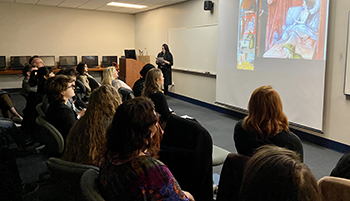Getting to Know You: Medieval Understanding of the Corporeal Self Through the Garden
Description/Abstract/Artist Statement
The body as an object of analysis is often underrepresented in medieval studies, attributable to its equal underrepresentation in the corpus of medieval literature. The body was viewed as a microcosm of the universe in the Middle Ages, understandable through the application of nature and the sciences to its various functions. The medieval garden too was a microcosmic representation of the sacred and secular worlds, as utilitarian or pleasure gardens respectively, representing the macrocosm of nature. Modern scholars have compiled from medieval works the information existing on how human bodies were understood medically and metaphysically, but have not ventured into what visual, tangible representations were employed to supplement the understanding of the body as a whole. Through assessments of the four elements as represented in the medieval garden, writings on the four humors, and medieval medical science, the stylistic designs of gardens are found to be a conceptual tool for the medieval comprehension of the corporeal self. From the physician Galen to the Roman de la Rose and the philosopher’s stone, the medieval garden was a conduit for comprehending one’s bodily functions and physical self in secular and sacred contexts.
[1] Green, Monica H, “Introduction,” in Linda Kalof, ed., A Cultural History of the Human Body in the Medieval Age (New York: Bloomsbury, 2010), 3-4.
Faculty Advisor/Mentor
Agnieszka Whelan
Presentation Type
Oral Presentation
Disciplines
Ancient, Medieval, Renaissance and Baroque Art and Architecture
Session Title
College of Arts & Letters 3
Location
Learning Commons @ Perry Library Room 1306
Start Date
2-8-2020 10:15 AM
End Date
2-8-2020 11:15 AM
Getting to Know You: Medieval Understanding of the Corporeal Self Through the Garden
Learning Commons @ Perry Library Room 1306
The body as an object of analysis is often underrepresented in medieval studies, attributable to its equal underrepresentation in the corpus of medieval literature. The body was viewed as a microcosm of the universe in the Middle Ages, understandable through the application of nature and the sciences to its various functions. The medieval garden too was a microcosmic representation of the sacred and secular worlds, as utilitarian or pleasure gardens respectively, representing the macrocosm of nature. Modern scholars have compiled from medieval works the information existing on how human bodies were understood medically and metaphysically, but have not ventured into what visual, tangible representations were employed to supplement the understanding of the body as a whole. Through assessments of the four elements as represented in the medieval garden, writings on the four humors, and medieval medical science, the stylistic designs of gardens are found to be a conceptual tool for the medieval comprehension of the corporeal self. From the physician Galen to the Roman de la Rose and the philosopher’s stone, the medieval garden was a conduit for comprehending one’s bodily functions and physical self in secular and sacred contexts.
[1] Green, Monica H, “Introduction,” in Linda Kalof, ed., A Cultural History of the Human Body in the Medieval Age (New York: Bloomsbury, 2010), 3-4.


